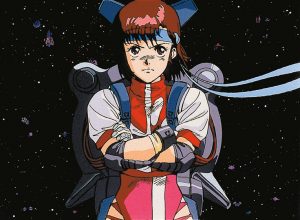
(Neo Magazine, Uncooked Media)
French director Jean-Luc Goddard declared, “All you need for a movie is a girl and a gun.” In the 1980s a gang of Japanese geeks declared, All you need for an anime is a girl and a mecha… Okay, make that a girl and tons of mecha, in a space war. The Japanese geeks were the staff of Gainax, and their girls-and-mecha opus was Gunbuster.
It’s the story of an extremely perky schoolgirl, Noriko, in the distant (!) future of 2023. Humanity is facing an alien invader, and Noriko – the daughter of an admiral lost in the war – wants to join the interstellar fight. The story starts at a girls’ school, with one of the funniest sight-gags in any anime. Giant robots are doing push-ups and sit-ups on a playing field, before teaming up to bully Noriko – and these robots pose exactly like the Mean Girls piloting them. Noriko herself seems an archetypal ditz, a no-hoper, so unsurprisingly she’s in space by part two and fighting galaxy-sized wars by the end.
The six-part video series can be watched in two ways; as a thrilling, crazy epic adventure with cute girls in space, or as a vortex of umpteen homages and allegories. Some in-jokes are obvious even if you’re not looking for them; for example, Noriko’s room in part 5 has Miyazaki posters on the wall. Others are poignant now, like a tragic male character in the series being called Toren Smith (reversed Japanese-style to “Smith Toren”), named after a pioneering US manga translator. The real Smith died in 2013, aged 52.
Gunbuster’s director was Hideaki Anno, future creator of Nadia, Evangelion and Shin Godzilla. Gunbuster was Anno’s director debut; until then he was known as an effects animator on anime like Nausicaa (the God Warrior) and Wings of Honneamise. Speaking in 2013, Anno said the move into direction was hard. “My personality doesn’t lend itself to direction… I was not functioning well on the first two (Gunbuster) episodes.” Perhaps these were the same personality issues that Anno would project onto Shinji in Evangelion.
However, Gainax co-founder Yasuhiro Takeda wrote in his book The Notenki Memoirs that, “Anno became completely obsessed with the (Gunbuster) project. For the first episode, he stuck pretty closely to the original script, but with each subsequent episode his own unique touch became increasingly apparent. For the last episode, he did the unthinkable – he filmed the episode entirely in black and white on colour film. Deliberately doing so cost the studio a lot more money, and a whole lot more effort than was necessary.” Anno claimed this last episode was inspired by seeing the Japanese superhero series Ultraman on monochrome television. “I realised special effects look better in black and white.”
Grounded in nostalgic fan feelings, Gunbuster is treasured by fans for whom it was one of “their” first anime. They could debate its treatment of SF concepts (see boxout), or how it sublimated Japanese feelings about World War II. Gunbuster’s lightweight first episode is set on the Japanese island Okinawa, which could be just an excuse to show balmy tropical backgrounds, or it could be to make deliberate associations. Okinawa was the site of one of the worst Pacific battles in 1945, where drafted Japanese schoolkids were among those fighting and dying against Allied troops.
More fans, though, remember Gunbuster for its fanservice, which is hilariously shameless (nothing beats Noriko flopping carelessly on a bed). The girls are often seen in cute leotards, modelled on those worn by Japanese gymnasts in the 1964 Tokyo Olympics. The girls’ animation in these garments added the phrase “Gaianax bounce” to the fan lexicon. Perhaps a bigger issue, though, is how the girls are characterised. Though they’re theoretically the heroes, they spend a great many scenes acting like irrational teen ninnies, dependent on manly characters like Smith Toren. This attitude may date Gunbuster more than anything else, yet the girls’ adventures still thrill.
(Short boxouts)
When Gunbuster was started, it was unclear how long it would run. For this reason, the fourth episode finished in a way that could have been an acceptable ending to the story (though the real conclusion is far more epic).
Confusingly, a scene in part 2 where the nude girls enjoy a Japanese-style shared bath seems to have been censored in some UK video copies, with 36 seconds cut, but not in others.
(Long boxouts)
Gunbuster makes prominent use of time dilation, the relativistic phenomenon that means Noriko can make a galactic journey in what seems like a short time to her, while months or years pass elsewhere. Time dilation was a major element in Joe Haldeman’s classic SF novel The Forever War (1974), with which Gunbuster is sometimes compared. Recently the same concept underpinned Christopher Nolan’s blockbuster film Interstellar. However, Anno himself linked Gunbuster to a famous Japanese fairy tale, “Urashima Taro,” where a luckless fisherman finds that three days in a magic undersea world equals three hundred years on the surface.
